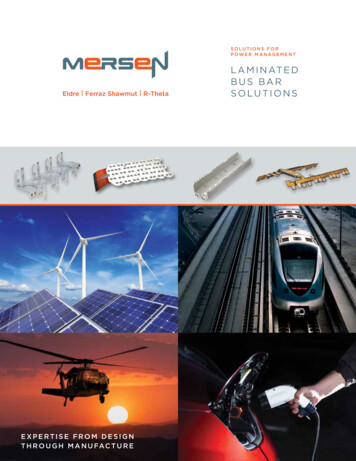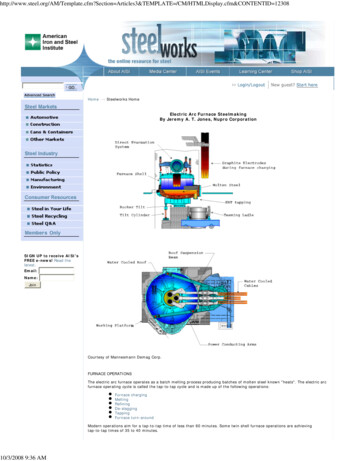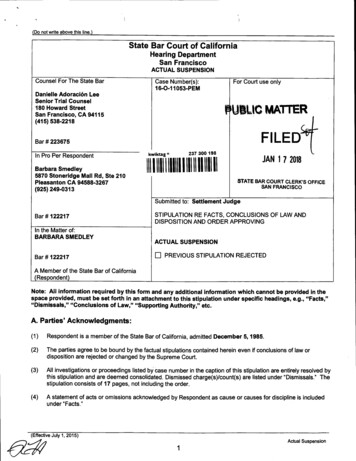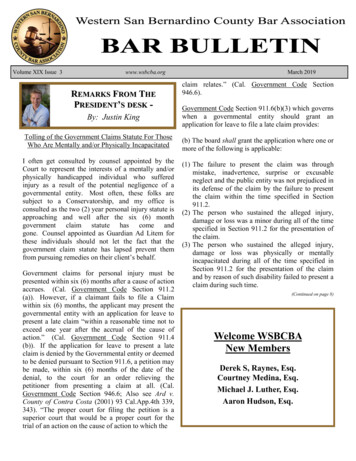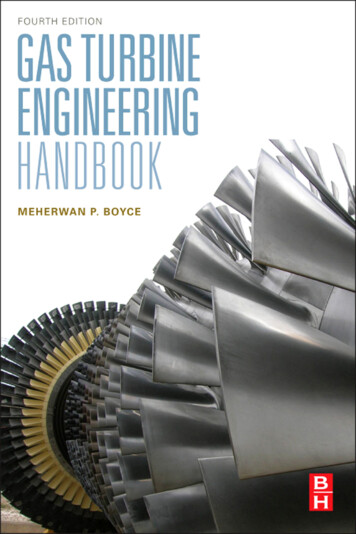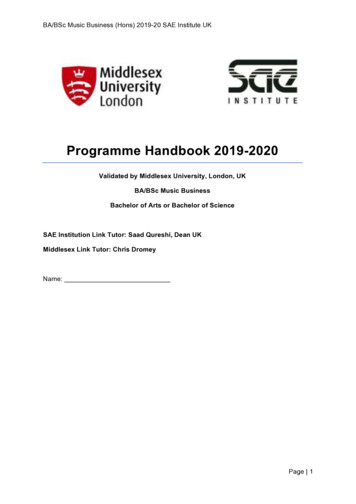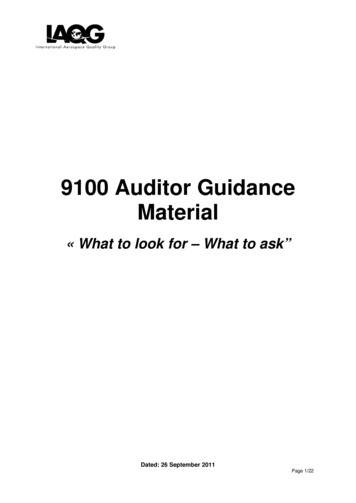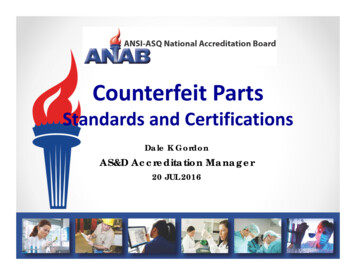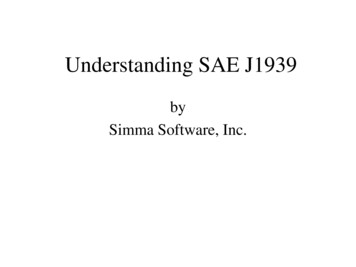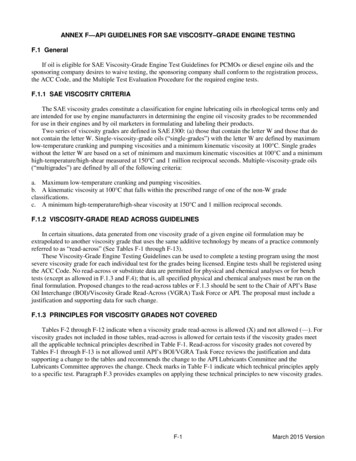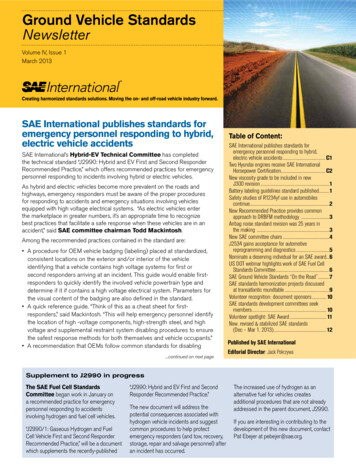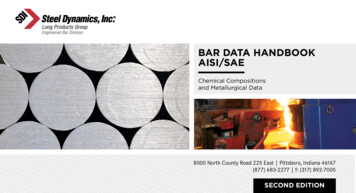
Transcription
BAR DATA HANDBOOKAISI/SAEChemical Compositionsand Metallurgical Data8000 North County Road 225 East Pittsboro, Indiana 46167(877) 683-2277 f: (317) 892-7005SECOND EDITION
TABLE OF CONTENTSINTRODUCTIONSDI OVERVIEWCOMPANY HISTORYPRODUCTS AND SERVICESPROCESS DESCRIPTION AND CAPABILITIES3457STEEL CHEMISTRIESMAJOR STEEL GROUPSAISI-SAE GRADE SERIES OVERVIEWSTANDARD CARBON STEELSRESULFURIZED CARBON STEELSREPHOSPHURIZED AND RESULFURIZED CARBON STEELSHIGH MANGANESE CARBON STEELSCARBON AND CARBON-BORON H-STEELSCHEMICAL RANGES AND LIMITS OF CARBON STEELSPERMISSIBLE VARIATIONS OF CARBON STEELSTANDARD ALLOY STEELSSTANDARD ALLOY H-STEELSSTANDARD ALLOY RH-STEELSSAE POTENTIAL STANDARD STEELSFORMER SAE EX AND PS STEELSFORMER STANDARD SAE STEELSBEARING QUALITY STEELSASTM A105ASTM A182ASTM A193ASTM A213ASTM A350ASTM A572ASTM A588ASTM A920CHEMICAL RANGES AND LIMITS OF ALLOY STEELSPERMISSIBLE VARIATIONS OF ALLOY STEELSSELECT AEROSPACE SPECIFICATIONSSELECT DIN 58596162636465666770HARDENABILITYSTANDARD HARDENABILITY REQUIREMENTSRESTRICTED HARDENABILITY REQUIREMENTSSELECT DIN HARDENABILITY REQUIREMENTS831071141
TABLE OF CONTENTSMECHANICAL PROPERTIESASTM A105ASTM A350ASTM A434ASTM A182ASTM A193ASTM A572ASTM A588ASTM A615ESTIMATED MECHANICAL PROPERTIES OF STEEL BARSMECHANICAL PROPERTY VARIATIONS WITH CARBON CONENT131131132133135136136137139150BAR PROPERTIESCOLD DRAWN OR TURNED AND POLISHED TOLERANCESRECOMMENDED COLD SHEARING LIMITATIONSCARBURIZING RATESRECOMMENDED MAXIMUM HOT WORKING TEMPERATURESCRITICAL TRANSFORMATION TEMPERATURESPERMISSIBLE VARATIONS IN HOT ROLLED BAR CROSS SECTIONSNOMINAL CORNER RADII OF RCS BARSPERMISSIBLE VARIATIONS IN HOT ROLLED LENGTHPERMISSIBLE VARIATIONS IN HOT ROLLED BAR STRAIGHTNESSEQUIVALENT CROSS SECTION BY BAR SIZE AND SHAPEHOT ROLLED BAR WEIGHTSHOT ROLLED BAR REDUCTION RATIOS AT SDI151152156157158160160161161163164167STEEL PROPERTIESGRAIN SIZEEFFECTS OF ALLOYING ELEMENTS ON STEEL PROPERTIES171172PRACTICAL INFORMATIONGLOSSARY OF METALLURGICAL TERMSROLES OF ALLOYING ELEMENTS IN STEELHEAT TREATING TERMSMECHANICAL PROPERTY TERMSMICROSTRUCTURAL TERMSSTEEL DEFECT TERMSHARDNESS CONVERSION TABLECOMMON COVERSION FACTORS1751761801831851871891912
STEEL DYNAMICS ENGINEERED BAR PRODUCTSCOMPANY OVERVIEWSteel Dynamics Incorporated (SDI) Engineered Bar Products Division is aworld class supplier of Special Bar Quality steel. The Engineered BarProducts Division is located in Pittsboro, Indiana, which is just west ofIndianapolis. The Engineered Bar Products facility offers a wide rangeof carbon, alloy, and custom designed steel grades to meet exactingcustomer demands.The major markets that are served by the Engineered Bar ProductsDivision include off highway construction equipment, agriculturalapplications, heavy truck, automotive, forging operations, and the gasand oil well industry.The Engineered Bar Products Division employs approximately 390employees and has an annual capacity of 625,000 tons.MISSION STATEMENTSteel Dynamics is committed to product and process improvement.Our mission statement is:To meet or exceed customer expectations with regard to quality,service, and priceTo be a world-class supplier by continually improving ourprocesses, equipment, and systemsTo be a safe working environment for all employeesTo continue to enhance the skills of our employees throughongoing training and educationISO 9001 CERTIFICATIONSteel Dynamics Engineered Bar Products Division attained ISO9001:2000 certification in September 2004.In January 2010, Steel Dynamics achieved ISO 9001:2008 certification.3
COMPANY HISTORYSDI purchased the mill in Pittsboro, Indiana, out of bankruptcy fromQualitech LLC in February 2003. Qualitech declared bankruptcy in 1999and ceased operations in 2001.A significant capital investment was undertaken to bring the existingfacility up to SDI standards, which included the following:Completely rebuilding the ladle metallurgy facility and theaddition of new ladle carsNew carbon and lime system and baghouse upgrades at theElectric Arc FurnaceThe continuous caster was modified to allow for the capacity tocast 7”x7” billetsAn 8 stand Morgardshammar finishing mill was added to theexisting Pomini millUpgrades were made to the shipping department, which handlesincoming scrap, as well as finished inventory and outgoingproductsAn additional 40 acres was purchased for rail infrastructure andscrap storageThe Engineered Bar Products Division made its first shipments of SBQproducts in December 2003, and the facility became profitable in April2004.An additional upgrade was made in mid 2006 to add a 150,000 squarefoot bar finishing facility with the capability to offer value addedservices such as heat treatment, straightening, turning and polishing,bar inspection, and precision cutting. The free-standing facility has thecapacity to finish 160,000 tons of bars annually.4
PRODUCTS AND SERVICESSDI produces special bar quality (SBQ) and merchant bar quality (MBQ)steel in rounds ranging in diameter from 1 to 9 inches and roundcornered squares (RCS) ranging in diameter from 2-1/2 to 8 inches. Thefacility also has the ability to produce rebar in sizes 5 through 11. Theproduction and availability of rebar is based on market conditions.SDI produces a wide range of carbon and low alloy steels, such as:Plain carbon steels (AISI series 10xx)Resulfurized carbon steels (AISI series 11xx)Rephosphorized and Resulfurized carbon steels (AISI series 12xx)High Manganese carbon steels (AISI series 13xx and 15xx)Cr Alloy Steels (AISI series 51xx and 52xx)Cr-Mo Alloy Steels (AISI series 41xx)Ni-Cr-Mo Alloy Steels (AISI Series 43xx, 47xx, 86xx, and 88xx)Vanadium micro-alloy steels (10V45, 11V41)Boron Treated SteelsStructural Grades ASTM A36 and A572 Grade 50Low Alloy Tube and Flange Grades (T2/F2, T11/F11, T22/F22)The grades listed above are a summary of those produced at theEngineered Bar Products facility. Please inquire for grades not listedabove or for custom designed grades.Hot-Rolled cut lengths are available between 16 and 40 feet. SteelDynamics can maintain all ASTM tolerances for diameter, length, andstraightness on all hot rolled products.The Engineered Bar Products Rolling Mill metallurgical lab has thecapability to provide the full spectrum of metallurgical testing includingtensile, hardness, charpy impact, grain size, jominy, microcleanliness,macrocleanliness, and aircraft quality testing.5
The Engineered Bar Products Bar Finishing facility is equipped toperform heat treating operations such as Quench and Temper,Normalizing, and Annealing (LP, Spheroidize, Cold Shear, StressRelieve). In addition to heat treating, the Bar Finishing facility canprovide additional services such as:StraighteningTurning and PolishingCutting to LengthShot BlastingNon Destructive TestingThe Bar Finishing Metallurgical Lab at Steel Dynamics has the capabilityto provide metallurgical testing such as tensile, hardness, and charpyimpact following heat treatment. The lab is also equipped with ascanning electron microscope that is used for research and productevaluation purposes.6
PROCESS DESCRIPTION AND CAPABILITIESMELTING AND CASTINGSDI is equipped with one Electric Arc Furnace (EAF). The EAF is chargedwith approximately 115 tons of primarily scrap metal in order to yieldan aim tapped heat size of 100 tons. Heats are killed following tap witha Silicon-Manganese addition.Following tap, heats are treated at a Ladle Metallurgy Facility (LMF). Atthe LMF, slag additions and modifiers are used to work the slag andtrap inclusions. Alloy additions are made at the LMF, as well as reheating the steel for further processing or shipment to the caster.Heats that require degas treatment have the slag layer removed bymeans of a mechanical rake. These heats are then treated at theVacuum Tank Degasser (VTD). Typical gas levels following VTDtreatment are 2 ppm H2, 80 ppm N2, and 20 ppm O2.The continuous caster is a three strand, vertical curved radius machine.Each strand is equipped with automatic mould level control andelectromagnetic stirring. Five withdrawal straightener units are used tostraighten the strands and also apply soft reduction. The dimensions ofthe semi-finished bloom are 10.3 x 14.1 inches.ROLLINGThe rolling mill is equipped with a walking beam furnace with a capacityof 125 tons per hour. Blooms are de-scaled after exiting the furnace,and then proceed through a five stand roughing mill, a six standintermediate mill, and an eight stand finishing mill. Dimensional controlis maintained by optical laser gauges and manual micrometer checks.Bars are sheared after reaching their final dimension onto a 125 feetlong walking beam cooling bed. Bars are then trimmed to the specifiedcut length and bundled together for shipment.7
HEAT TREATINGThe Bar Finishing facility is equipped with five Sauder Energy CarBottom furnaces. There is one high temperature furnace capable ofreaching 2100 F, while the others are capable of reaching 1800 F. Thefurnaces are limited to a maximum bar length of 33 feet. The quenchtank has a 30,000 gallon capacity and is capable of providing agitationand temperature control. Water is the only quench media used at theBar Finishing facility. The minimum bar diameter that can be quenchedis 2.5 inches.BAR INSPECTIONThere are two inspection lines at the Bar Finishing facility, a small barinspection line (SBIL) and a large bar inspection line (LBIL). The SBIL canaccommodate round bars ranging in diameter from one to five incheswhile the LBIL can accommodate round bars from 2.5 to 9 inches andround cornered squares from 2.5 to 8 inches. Both lines canaccommodate bar lengths of 15 to 45 feet.At the SBIL, bars are rotary straightened and chamfered prior toinspection. Surface inspection is performed via a Forester MagneticFlux Leakage unit, capable of 100% surface coverage with seamdetection of 0.3 mm for smaller bars and 0.5 mm for larger bars.Ultrasonic inspection is performed via a rotary immersion UT inspectionunit, capable of 100% volumetric coverage using normal incidence andshear waves. Ultrasonic inspection is capable of detecting 1mm widedefects. The SBIL is also equipped with a 100% Eddy Current gradeverification coil.On the LBIL, bars are shot blasted and pass through an Eddy Currentgrade verification coil. Surface inspection is performed via an EddyCurrent surface inspection unit, capable of 100% surface coverage withseam detection of 0.5mm. Ultrasonic inspection is performed via aMagnetic Analysis Corp 48 channel transducer with four fixed heads,capable of 100% volumetric coverage. Ultrasonic inspection is capableof detecting 1mm wide defects.8
TURNING AND POLISHINGThe turning line has a capacity of 1.031 inch to 4.25 inch incomingdiameter, and is capable of meeting ASTM A108 tolerances. The linecan accommodate bar lengths ranging from 14 to 25 feet. The line isequipped with bar chamfering, facing, and etching capabilities. Thestraightener/polisher is capable of attaining greater than 25Ra surfacefinish. The turning line is equipped with an Eddy Current tester forsurface inspection.STRAIGHTENINGThe bar finishing facility has a Bronx Nine Roll straightener and a #5Medart Two Roll straightener. The units are capable of meeting bothstandard and special straightness tolerances as listed in ASTM A29.MULT CUT-TO-LENGTH SAWINGCut-to-length sawing is accomplished with two Nishijimax PrecisionCarbide Rotary Saws, with a capacity of 1.00 to 5.9 inch rounds. Thesaws can produce cut lengths from 0.5 to 118 inches, with a standardlength tolerance of /- 0.010” or 0.25 mm.A Hem High Speed Double Column band saw line is also available. It hasa capacity of 4 to 25 inch rounds as well as being able to cut bundles.Cut lengths are available from 5 to 24 feet, with a tolerance of -0/ 0.25inches.9
NOTES10
MAJOR STEEL GROUPSCarbon SteelCarbon steel usually contains up to 1.65% manganese, and contains noother added elements to provide any specific alloying effects, except fordeoxidation or grain size control. Carbon steels are often classifiedaccording to carbon concentration, i.e. low, medium, and high carbonsteels. The term ‘plain carbon steel’ is often used to describe steelswhich only contain residual concentrations of impurities other thancarbon and manganese.The greatest quantity of steel produced falls into the low-carbonclassification, and is typically less than 0.25% carbon. Low-carbon steelsare typically unresponsive to heat treatments intended to formmartensite and strengthening is usually accomplished through coldworking. Low-carbon steels are relatively soft and weak but haveexcellent ductility and toughness.Medium-carbon steels have carbon concentrations typically between0.25% and 0.60%, and may be heat treated by austenitizing, quenching,and tempering to improve their mechanical properties. Mediumcarbon steels are stronger than low-carbon steels, but with a reductionin ductility and toughness. High-carbon steels have carbonconcentrations typically between 0.60% and 1.4%, and are the hardestand strongest of the carbon steels, but with the least amount ofductility.Microalloy SteelMicroalloy steels, or High Strength Low Alloy (HSLA) steels, are a groupof low-carbon steels which contain a small but deliberate addition ofone or more alloying elements such as: vanadium, columbium, andtitanium. These steels have increased strength, combined with goodductility in the hot rolled condition. These properties are achieved by acombination of fine grain size and precipitation of finely dispersedparticles throughout the steel’s microstructure. Some HSLA steels haveimproved atmospheric corrosion.Alloy SteelSteel containing significant quantities of one or more alloying elements(other than carbon and the commonly accepted amounts ofmanganese, and silicon) added to make changes in mechanical orphysical properties. Common alloying elements include nickel,chromium, and molybdenum, among oth
diameter, and is capable of meeting ASTM A108 tolerances. The line can accommodate bar lengths ranging from 14 to 25 feet. The line is equipped with bar chamfering, facing, and etching capabilities. The straightener/polisher is capable of attaining greater than 25Ra surface finish. The turning line is equipped with an Eddy Current tester for
